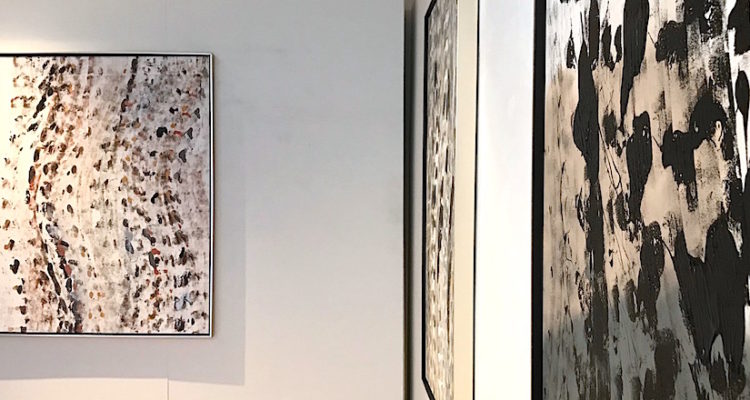By Peter Harper
At the basis of Alejandra Stier’s remarkable new series of large acrylic on canvas paintings exhibited at Artifact (84 Orchard Street, NYC) is the artist’s evident understanding of metamorphosis and mutability. This principle of flow and semi-translucency is at the core of her new work. It permeates all of her works, rendering it pliable and playfully synthetic while emphasizing patterns of endless suggestibility. The artist has applied a set of aesthetic procedures such as addition, subtraction, layering, interweaving imagery to create diaphanous worlds, which stress the integration of parts to the whole as well as the reverse.
Stier sets up a chain of visual correspondences between blocks of fluid abstract parts and the still background as well as mostly monochromatic surfaces with intrusions of color. The artist seems determined to eliminate a separation by a series of operations and deliberative artistic interventions which intend to articulate the abstract dynamics, rendering it positively ambiguous and poetically evocative. Alejandra Stier seems to be treating the pictorial surface as a continuously regenerating memory machine, which evokes emotions, yet rearranging them or interleaving them to fit the moment of the mind’s recognition.
Her recombinatory effects create singularly and subversively miasmic spatial fields, which are at once illimitable and calm while also sparkling with musical vitality. This peculiarly double-sided sensation reflects an essential characteristic of the artist’s work. Her mature and repeated considerations on the objectivity of the world regarded with playful subjectivity, as if it were experiencing the stream of life and its myriad events for the first time.
Each of the artist’s works features some recognizable vestigial form. Often, these forms are broken into splashes and spills of contrasting; each shape manages to convey the essence of individuation and can stand truly alone. This is so while the fragmented quality of each composition never appears arbitrary. The shapes and forms within larger overall forms elude becoming too uncontrolled as coherence settles over each work.
